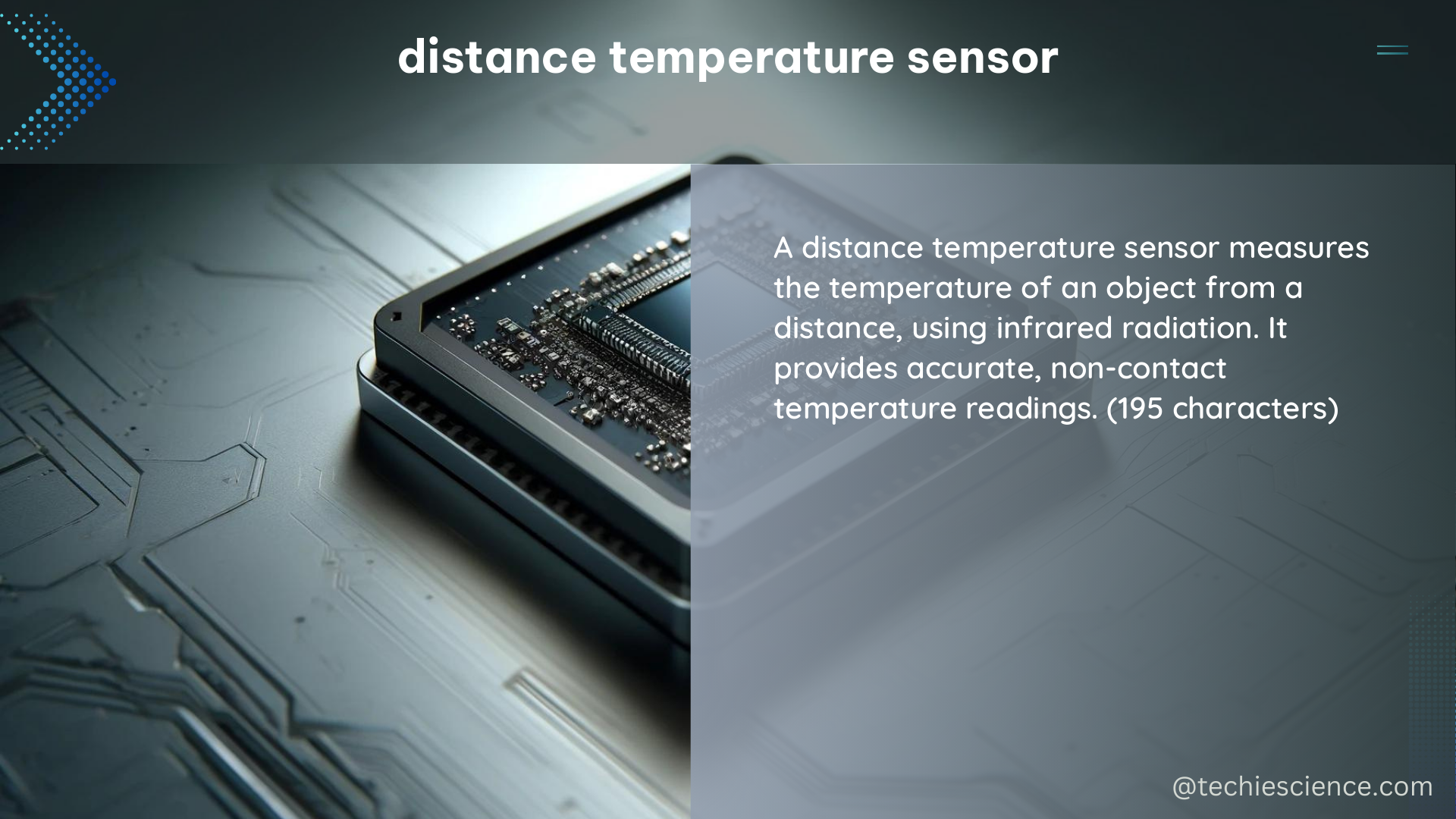A distance temperature sensor is a versatile device that can accurately measure both the temperature and the distance of an object or surface. These sensors employ advanced techniques, such as time-of-flight (ToF) and triangulation, to provide precise measurements, making them invaluable in a wide range of applications, from industrial automation to medical diagnostics.
Understanding the Principles of Distance Temperature Sensors
Distance temperature sensors operate on the fundamental principle of combining a temperature sensor, such as a thermistor or an infrared sensor, with a distance measurement technique. This integration allows for the simultaneous acquisition of both temperature and distance data, providing a comprehensive understanding of the target object or surface.
Temperature Measurement Techniques
- Thermistor-based Sensors: Thermistors are temperature-sensitive resistors that exhibit a significant change in resistance with temperature variations. They offer high accuracy, fast response times, and a wide temperature range, making them a popular choice for distance temperature sensors.
- Infrared (IR) Sensors: Infrared sensors measure the thermal radiation emitted by an object, allowing for contactless temperature measurement. These sensors are particularly useful for measuring the temperature of moving or inaccessible targets.
Distance Measurement Techniques
- Time-of-Flight (ToF): ToF sensors use a pulsed light source, such as a laser or LED, to measure the time it takes for the light to reflect off the target and return to the sensor. This time measurement is then used to calculate the distance to the object.
- Triangulation: Triangulation-based sensors use two or more light sources and detectors to determine the distance to an object by analyzing the angles of the reflected light. This technique is effective for short-range distance measurements.
Exploring Advanced Distance Temperature Sensor Technologies

MLX90632 SMD QFN Sensor
The MLX90632 SMD QFN is a prime example of a high-performance distance temperature sensor. This sensor can measure the temperature of an object or surface within a distance of up to 1 meter, with an impressive accuracy of ±0.2°F (±0.1°C). The device incorporates a ToF infrared laser sensor to provide accurate distance measurements, ensuring that the temperature readings are taken at the correct physical distance.
Key Specifications of the MLX90632 SMD QFN Sensor:
– Temperature Range: -40°C to 300°C
– Distance Range: Up to 1 meter
– Accuracy: ±0.2°F (±0.1°C)
– Response Time: 100 ms
– Power Consumption: 15 mW
– Interface: I2C
TMP6 Thermistor and Differential Temperature Measurements
The TMP6 thermistor is another versatile distance temperature sensor that can be used in the technique of differential temperature measurements. This approach involves using two temperature sensors, such as TMP6 thermistors, to measure the temperature difference between two points on a device or circuit board. This can provide a more accurate assessment of the temperature of a critical component, especially in complex thermal environments.
Key Specifications of the TMP6 Thermistor:
– Temperature Range: -55°C to 150°C
– Response Time: 100 ms
– Power Consumption: 1 µW
– Interface: Digital or Analog
Selecting the Right Distance Temperature Sensor
When choosing a distance temperature sensor, it is essential to consider a range of technical specifications and factors to ensure the best fit for your application. Some key considerations include:
- Temperature Range: Ensure the sensor can measure the required temperature range for your application, whether it’s cryogenic, ambient, or high-temperature environments.
- Distance Range: Determine the maximum distance at which you need to measure the temperature and select a sensor with a suitable range.
- Accuracy: Understand the required level of temperature and distance measurement accuracy for your application and choose a sensor that meets or exceeds those requirements.
- Response Time: Consider the speed at which the sensor needs to respond to temperature and distance changes, and select a sensor with an appropriate response time.
- Power Consumption: Evaluate the power requirements of the sensor, especially for battery-powered or energy-efficient applications.
- Interface Options: Determine the most suitable interface (e.g., I2C, digital, analog) for your system and select a sensor that provides the necessary connectivity.
- Ease of Use and Integration: Assess the sensor’s ease of integration into your existing system, including any additional components or circuitry required.
Conclusion
Distance temperature sensors are invaluable tools that combine the measurement of temperature and distance, providing a comprehensive understanding of the target object or surface. By exploring the principles, advanced technologies, and selection criteria for these sensors, you can unlock a world of possibilities in various industries, from industrial automation to medical diagnostics. Mastering the art of distance temperature sensing can lead to enhanced system performance, improved efficiency, and better-informed decision-making.
References:
– Texas Instruments. (2021). Component Temperature Monitoring Using Differential Temperature Measurements. Retrieved from https://www.ti.com/lit/an/snia044/snia044.pdf?ts=1705832999601
– Kumar, A., & Kumar, A. (2022). Contactless temperature and distance measuring device: A low-cost, novel infrared ―based ‘Badge’-shaped structural model for measuring physical distance and body temperature. AIMS Electronics and Electrical Engineering, 6(1), 43-60. doi: 10.3934/electreng.2022004
– Pereira, M., & Glisic, B. (2023). Detection and quantification of temperature sensor drift using probabilistic neural networks. Sensors, 23(6), 3142. doi: 10.3390/s23063142
– Melexis. (n.d.). MLX90632 SMD QFN Datasheet. Retrieved from https://www.melexis.com/en/product/mlx90632/infrared-thermometer-ic
– Vishay. (n.d.). TMP6 Datasheet. Retrieved from https://www.vishay.com/docs/29048/tmp6.pdf

The lambdageeks.com Core SME Team is a group of experienced subject matter experts from diverse scientific and technical fields including Physics, Chemistry, Technology,Electronics & Electrical Engineering, Automotive, Mechanical Engineering. Our team collaborates to create high-quality, well-researched articles on a wide range of science and technology topics for the lambdageeks.com website.
All Our Senior SME are having more than 7 Years of experience in the respective fields . They are either Working Industry Professionals or assocaited With different Universities. Refer Our Authors Page to get to know About our Core SMEs.